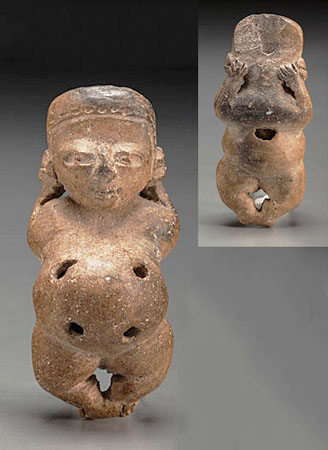
Owner: HWMC
Catalog#: 2LA-AEBH-16
Provenance: Silberman Collection of Pre-Columbian and Tribal Art, Dallas, Texas
Edge-blown Flutes
Guatemala ‘Olmec Ocarina’
Guatemala, Pacific Lowlands
Olmec
Pottery
ca. 400 BCE-200 CE
Height: 3.25 in
Aerophones – Wind Instruments Proper – Edge-blown Flutes
This Olmec pottery ocarina is made in the shape of a round bellied female, apparently in a birthing position. The effigy ocarina is crafted with four finger holes on the stomach and a whistle hole to blow into behind the head. Both hands are positioned behind her neck in the back. The provenance identifies that it came from the Olmec of the Guatemala Lowlands.
Dr. Richard Hansen, Director of the Mirador Basin archaeological project in northern Petén – a region of northern Guatemala, bounded by Mexico to the north and west and by Belize to the east, disputes the common belief that the Olmec were the mother culture in Mesoamerica. Due to recent findings in the Mirador Basin, Hansen suggests that Olmec and Maya cultures developed separately, and then merged in some areas, such as Tak’alik Abaj, in Retalhuleu of the Pacific lowlands, a pre-Columbian archaeological site in Guatemala. The earlier Olmec culture had emerged, and centered on the San Lorenzo Tenochtitlán (Mexico) site near the coast in southeast Veracruz as early as 1500 BCE to about 400 BCE. The provenance of this ocarina shows the archaeological location as Guatemala, ca 400 BCE – 200 CE.
Resource: ‘Cultural; and Environmental Components of the First Maya States: A Perspective from the Central and Southern Maya Lowlands.’ Richard Hansen, University of Utah, Anthropology, Adjunct.
